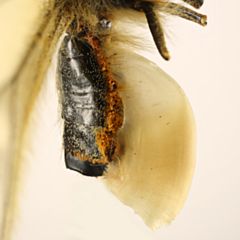Project 3836: A. P. S. Carvalho, A. G. Orr, A. Y. Kawahara. 2017. A review of the occurrence and diversity of the sphragis in butterflies (Lepidoptera, Papilionoidea). ZooKeys. 694:41-70.

Specimen: Parnassius mnemosyne (Linnaeus, 1758) (Florida Museum of Natural History)
View: Lateral
View: Lateral
Abstract
Males of many butterfly species secrete long-lasting mating plugs to prevent their mates from copulating with other males, thus ensuring their sperm will fertilize all future eggs laid. Certain species have further developed a greatly enlarged, often spectacular, externalized plug, termed a sphragis. This distinctive structure results from complex adaptations in both male and female genitalia and is qualitatively distinct from the amorphous, internal mating plugs of other species. Intermediate conditions between internal plug and external sphragis are rare. The term sphragis has often been misunderstood in recent years, hence we provide a formal definition based on accepted usage throughout most of the last century. Despite it being a highly apparent trait, neither the incidence nor diversity of the sphragis has been systematically documented. We record a sphragis or related structure in 273 butterfly species, representing 72 species of Papilionidae in 13 genera, and 201 species of Nymphalidae in 9 genera. These figures represent respectively, 13% of Papilionidae, 3% of Nymphalidae, and 1% of known butterfly species. A well-formed sphragis evolved independently in at least five butterfly subfamilies, with a rudimentary structure also occurring in an additional subfamily. The sphragis is probably the plesiomorphic condition in groups such as Parnassius (Papilionidae: Parnassiinae) and many Acraeini (Nymphalidae: Heliconiinae). Some butterflies, such as those belonging to the Parnassius simo group, have apparently lost the structure secondarily. The material cost of producing the sphragis is considerable. It is typically offset by production of a smaller spermatophore, thus reducing the amount of male-derived nutrients donated to the female during mating for use in oogenesis and/or somatic maintenance. The sphragis potentially represents one of the clearest examples of mate conflict known. Investigating its biology should yield testable hypotheses to further our understanding of the selective processes at play in an ‘arms race’ between the sexes. This paper provides an overview, which will inform future study.Read the article »
Article DOI: 10.3897/zookeys.694.13097
Project DOI: 10.7934/P3836, http://dx.doi.org/10.7934/P3836
| This project contains |
|---|
Download Project SDD File |
Currently Viewing:
MorphoBank Project 3836
MorphoBank Project 3836
- Creation Date:
16 October 2020 - Publication Date:
26 October 2020
This research
supported by
Authors' Institutions ![]()
- University of Florida
- Griffith University
